
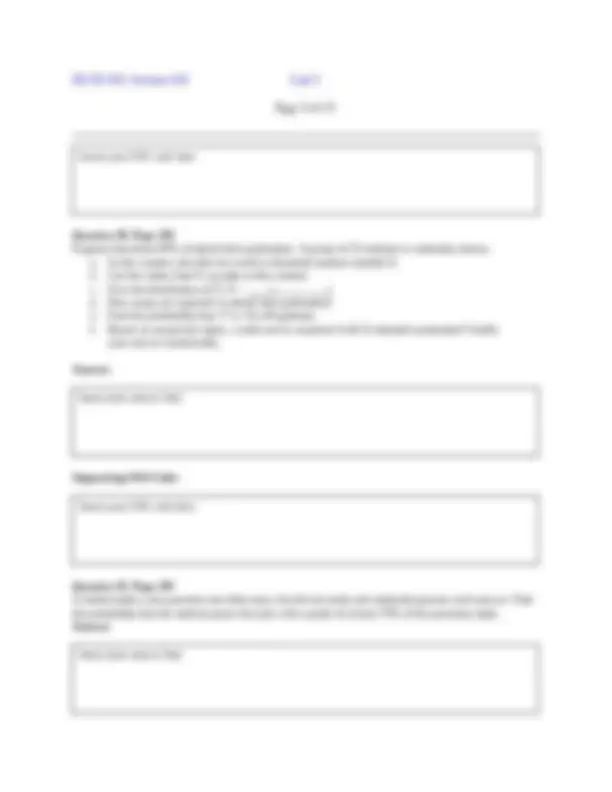
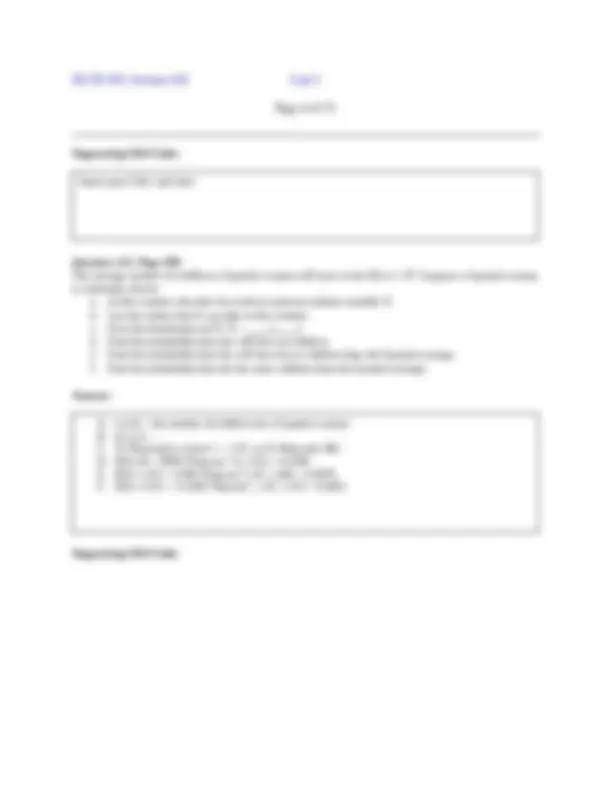
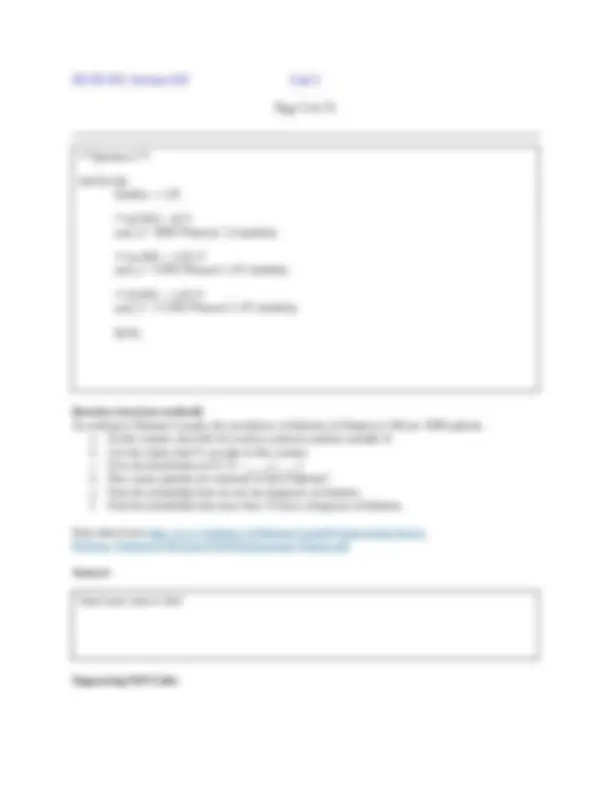
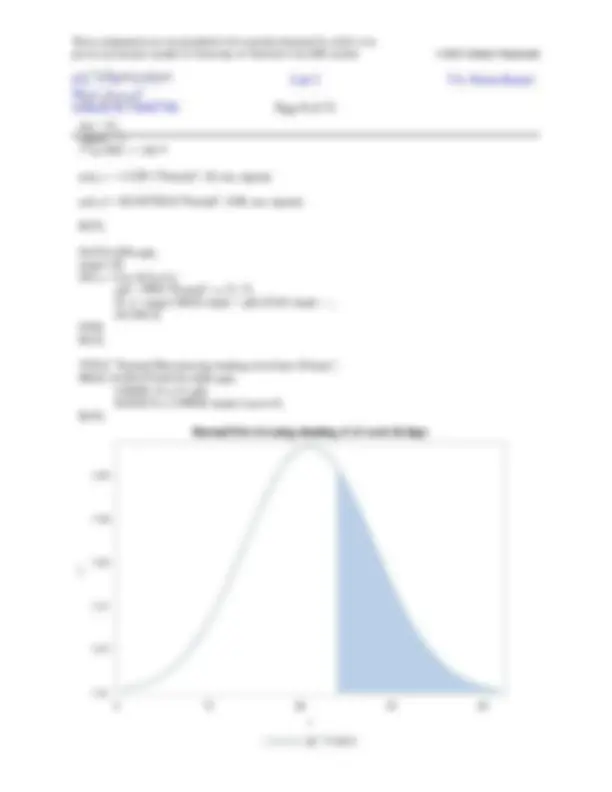


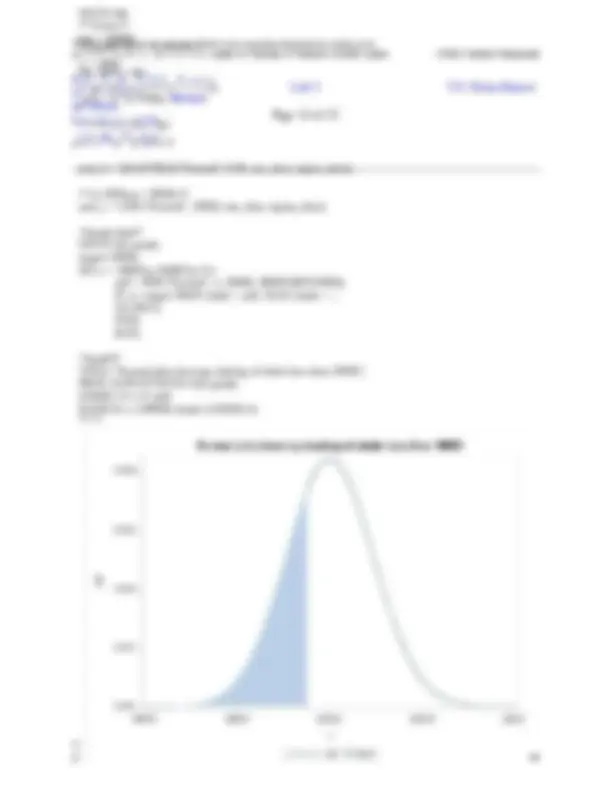
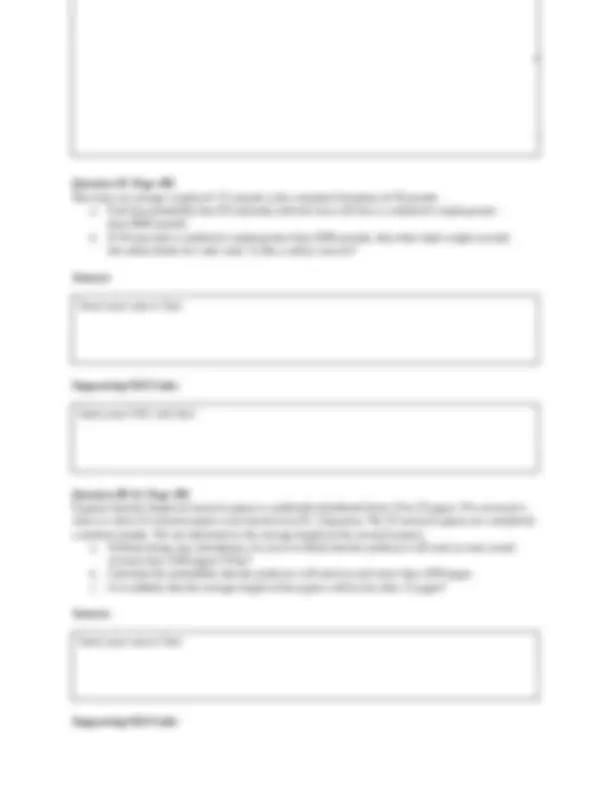



Study with the several resources on Docsity

Earn points by helping other students or get them with a premium plan


Prepare for your exams
Study with the several resources on Docsity

Earn points to download
Earn points by helping other students or get them with a premium plan
Community
Ask the community for help and clear up your study doubts
Discover the best universities in your country according to Docsity users
Free resources
Download our free guides on studying techniques, anxiety management strategies, and thesis advice from Docsity tutors
Question 95. Page 293 More than 96% of the largest colleges and universities (>15,000 enrollments) have some online course offerings. Suppose you randomly pick 13 such institutions. We are interested in the number that offer distance learning courses. a. Define the random variable X. b. List the possible values that X might take on. c. Give the distribution of X. X ~ ( , ) d. On average, how many schools would you expect to offer such courses? e. Find the probability that at most ten offer such courses. f. Is it more likely that 12 or that 13 will offer such courses? Use numbers to justify your answer numerically and answer in a complete sentence. Answer:
Typology: Exams
1 / 15

This page cannot be seen from the preview
Don't miss anything!










a. Let X be the number of California residents who have adequate earthquake supplies. b. X can take on the following values (0,1,2,3,4,5,6,7,8,9,10,11) c. X ~ Binomial (p,n) where p = 0.3 and n =11, so X – Binomial (0.3,11) d. P(X>=8) = 1-P(X<=7) = 1-CDF (‘Binomial, 7, 0.30, 11) =0. e. P(X=0) = 0.0197732674 > P(X=11) =1.77147E- 6 a. More likely that none of the residents have supplies. f. E(X) = np=110.30=3.3 so 3.3 residents are expected to have earthquake supplies. Be sure to support your solutions with the supporting SAS code, where appropriate. Question 95. Page 293 More than 96% of the largest colleges and universities (>15,000 enrollments) have some online course offerings. Suppose you randomly pick 13 such institutions. We are interested in the number that offer distance learning courses. a. Define the random variable X. b. List the possible values that X might take on. c. Give the distribution of X. X ~ ( , ) d. On average, how many schools would you expect to offer such courses? e. Find the probability that at most ten offer such courses. f. Is it more likely that 12 or that 13 will offer such courses? Use numbers to justify your answer numerically and answer in a complete sentence. Answer: Supporting SAS Code:
Insert your answer here
Question 100. Page 295 It has been estimated that only about 30% of California residents have adequate earthquake supplies. Suppose you randomly survey 11 California residents. We are interested in the number who have adequate earthquake supplies. a. Define the random variable X. b. List the possible values that X might take on. c. Give the distribution of X. X ~ ( , ) d. What is the probability that at least eight have adequate earthquake supplies? e. Is it more likely that none or that all of the residents surveyed will have adequate earthquake supplies? Why? f. How many residents do you expect will have adequate earthquake supplies? Answer: Supporting SAS Code: /* Question 1 / DATA Q1; n = 11; p = 0.3; / (d) (X >=8) = 1 - BinomCDF(x,p,n) / part_d = 1 - CDF('Binomial', 7, p, n); / (e) P(X = 0) > P(X=11) / part_e0 = PDF('Binomial', 0, p, n); Part_e11 = PDF('Binomial', 11, p, n); / (f) E(X) / part_f = np; RUN;
Insert your SAS code here A. Let X = the number of children for a Spanish woman B. 0,1,2,3…. C. X~Poisson(λ), where λ = 1.47, so X~Poisson(1.46) D. P(X=0) = PDF(“Poisson,” 0, 1.47) = 0. E. P(X<1.47) = CDF(“Poisson,”1.47, 1.46) = 0. F. P(X>1.47) = 1-CDF(“Poisson”, 1.47, 1.47) = 0.
Supporting SAS Code: Question 121. Page 298 The average number of children a Spanish woman will have in her life is 1.47. Suppose a Spanish woman is randomly chosen. a. In this context, describe (in words) a poisson random variable X. b. List the values that X can take in this context. c. Give the distribution of X. X ~ ( ) d. Find the probability that she will have no children. e. Find the probability that she will have fewer children than the Spanish average. f. Find the probability that she has more children than the Spanish average. Answer: Supporting SAS Code:
Insert your answer here
Question (not from textbook) According to Diabetes Canada, the prevalence of diabetes in Ontario is 100 per 1000 patients. a. In this context, describe (in words) a poisson random variable X. b. List the values that X can take in this context. c. Give the distribution of X. X ~ ( ) d. How many patients are expected to have diabetes? e. Find the probability that no one has diagnosis of diabetes. f. Find the probability that more than 75 have a diagnosis of diabetes. Data taken from https://www.diabetes.ca/DiabetesCanadaWebsite/media/About- Diabetes/ Diabetes%20Charter/2019-Backgrounder-Ontario.pdf Answer: Supporting SAS Code: /* Question 2 / DATA Q2; lambda = 1.47; / (d) P(X = 0) / part_d = PDF("Poisson", 0, lambda); / (e) P(X < 1.47) / part_e = CDF("Poisson",1.47, lambda); / (f) P(X > 1.47) */ part_f = 1-CDF("Poisson",1.47, lambda); RUN;
A. Let X = the distribution of the number of days a particular type of criminal trial will take B. X~Normal ( 𝜇 ,σ), where u=mean and σ= std. so X ~ Normal (21,7) C. P(X>=24) = 1-CDF (” Normal”, 24, 21, 7) = 0.334 The probability that a randomly selected trial will last more than 24 days is 0.334. D. P(X<=?) = 0.60? = QUANTILE (“Normal”, 0.60, 21, 7) = 22.77. 60% of all trials of this type are completed within 22.77 days.
Answer: Supporting SAS Code:
These assignments are not permitted to be reproduced/posted in whole or in part in any manner outside of University of Waterloo’s LEARN system. ©2021 Ashok Chaurasia
mu = 21; sigma = 7; /* (c) P(X >= 24) */ part_c = 1-CDF ("Normal", 24, mu, sigma); part_d = QUANTILE("Normal", 0.60, mu, sigma); RUN; DATA Q3Graph; target=24; DO x = 0 to 42 by 0.1; pdf = PDF("Normal", x, 21, 7); IF x>=target THEN shade = pdf; ELSE shade = .; OUTPUT; END; RUN; TITLE "Normal Plot showing shading of at least 24 days"; PROC SGPLOT DATA=Q3Graph; SERIES X=x Y=pdf; BAND X=x UPPER=shade Lower=0; RUN;
Insert your answer here Insert your SAS code here Insert your answer here Question 88. Page 394 Facebook provides a variety of statistics on its website that detail the growth and popularity of the site. On average, 28% of 18- to 34-year-olds check their Facebook profiles before getting out of bed in the morning. Suppose this percentage follows a normal distribution with a standard deviation of 5%. a. Find the probability that the percent of 18- to 34-year-olds who check Facebook before getting out of bed in the morning is at least 30. Provide a supporting graph and an interpretation statement. b. Find the 95 th^ percentile and express it in a sentence. Answer: Supporting SAS Code: Question 73. Page 390 A study found that the height for Asian adult males is normally distributed with an average of 66 inches and a standard deviation of 2.5 inches. Suppose one Asian adult male is randomly chosen. Let X = height of the individual. a. X ~ ( , ) b. Find the probability that the person is between 66 and 72 inches. Include a graph and write a probability statement. c. What are the chances of selecting an Asian adult male over 70 inches? Explain why or why not, and justify your answer numerically. Answer: Supporting SAS Code:
Adapted from Question 69. Page 432 The distribution of income in some developing countries is considered wedge-shaped (many low-income people, few middle-income people, even fewer high-income people). Suppose we select a country with a wedge-shaped distribution. Let the average salary be $20,000 per year with a standard deviation of $3000. We randomly survey 1000 residents of that country. a. If a person from this population is randomly selected, find the probability that their salary is less than $1600 per year. Create the associated graph. b. Find the 65 th^ percentile for average salary. Answer: Insert your SAS code here
These assignments are not permitted to be reproduced/posted in whole or in part in any manner outside of University of Waterloo’s LEARN system. ©2021 Ashok Chaurasia
/* Given */ These^ mu^ = assignments^ 20000; are not permitted to be reproduced/posted in whole or in pa s r i t g i m n a a n
y
m
a
n
n
e r outside of University of Waterloo’s LEARN system. ©2021 Ashok Chaurasia n = 1000; mu_xbar = mu;
s
ig
m
a_
x
b
a
r
s
i
g
m
a
part_b = QUANTILE("Normal", 0.65, mu_xbar, sigma_xbar); /* (c) P(Xbar< 19950) / part_c = CDF("Normal", 19950, mu_xbar, sigma_xbar); /graph data/ DATA Q4_graph; target=19950; DO x = 19600 to 20400 by 0.1; pdf = PDF("Normal", x, 20000, 3000/SQRT(1000)); IF x<=target THEN shade = pdf; ELSE shade = .; OUTPUT; END; RUN; /graph*/ TITLE "Normal plot showing shading of xbabr less than 19950"; PROC SGPLOT DATA=Q4_graph; SERIES X=x Y=pdf; BAND X=x UPPER=shade LOWER=0; RUN;
These assignments are not permitted to be reproduced/posted in whole or in part in any manner outside of University of Waterloo’s LEARN system. ©2021 Ashok Chaurasi
Insert your answer here Insert your SAS code here Insert your answer here Question 92. Page 436 Men have an average weight of 172 pounds with a standard deviation of 29 pounds. a. Find the probability that 20 randomly selected men will have a combined weight greater than 3600 pounds. b. If 20 men had a combined weight greater than 3500 pounds, then their total weight exceeds the safety limits for water taxis. Is this a safety concern? Answer: Supporting SAS Code: Question 88 i-k. Page 436 Suppose that the length of research papers is uniformly distributed from 10 to 25 pages. We surveyed a class in which 55 research papers were turned in to Dr. Chaurasia. The 55 research papers are considered a random sample. We are interested in the average length of the research papers. a. Without doing any calculations, do you it is likely that the professor will need to read a total of more than 1050 pages? Why? b. Calculate the probability that the professor will need to read more than 1050 pages. c. Is it unlikely that the average length of the papers will be less than 12 pages? Answer: Supporting SAS Code: a